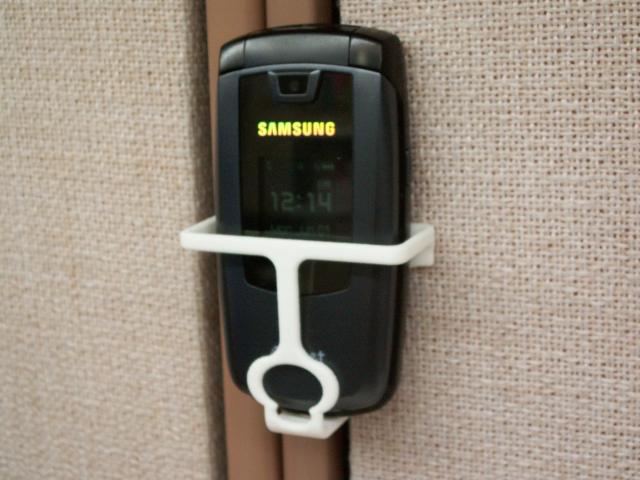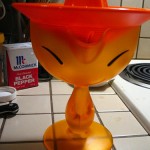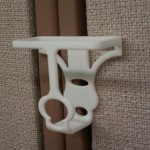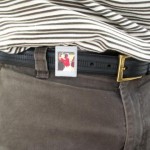
For someone working at a 3D printing start up I am a bit of a technology skeptic. I think it comes from being promised too much, from the whole “in five years..” thing. It is now 2009 and still my fridge does not go on the internet and order my food from Webvan for me. I still have to go out and buy my clothes from an actual store and not boo.com (which by the way is now a social/community travel site). I am waiting for my own cold fusion reactor but do not spend this time having company meetings on Second Life. The present is always so much more mundane and less sparkly than the future. One of my favorite T-shirts sums this up quite nicely.
My skepticism is also reinforced by all the awesome production processes, 3D apps and other technologies that we scout out at work only to discover that the concept is wonderful but they just do not work. In the hype cycle I am almost permanently skating down the “peak of inflated expectations” towards the “trough of disillusionment.” Side note: where is the hype cycle currently on the hype cycle?
With this in mind..this is the future:
1. Virtually everyone will be able to make their own real stuff. The items that will be made will be ‘gifts’ (to themselves and others) whereby the cost of customizing & creating the item shall be roughly half the utility of said item and comparable to the cost of a mass produced item with obviously demonstrable less utility. For some, the customization itself or the benefit of making your own product might be fun and this will change the equation and enable them to give more design time to the product or expect less utility from it.
2. Furthermore, many people will become their “brand of one” and rather than working for a design bureau or IKEA will directly retail their own products using services such as Shapeways for selling art, design objects, household objects & other products.
So, it is not exactly a pithy battle cry or memorable manifesto sentence, but in comparison with those I think that this has much more than a coin flips’ chance of actually coming true.
Some qualifications:
Not everyone will do this. Some can not, some will be unwilling.
We will not be able to make everything. Below are six rather broad categories of items and why and how they would be suitable for on demand creation:
Mega technologically complex: It does not, regardless of the technology, make sense for one person or a group of interconnected people online to make a Boeing 777. The regulatory & liability issues would be immense. The undertaking of such a project would also bring about so much complexity in the organization of it that synergies of collectively working on the project would evaporate. The financial burden would also be excessive.
 Mechanically complex but modular: Anything less complex: a car, light airplane, boat, bike, etc. could be & will be created, eventually. For these items most of the utility comes from scale but a lot can be added by customization and on demand creation. For this category however it would be more logical to combine a lot of mass produced components, select other mass produced components and combine them with a customized body for example. The creation on demand for this category of items would be in the assembly.
Mechanically complex but modular: Anything less complex: a car, light airplane, boat, bike, etc. could be & will be created, eventually. For these items most of the utility comes from scale but a lot can be added by customization and on demand creation. For this category however it would be more logical to combine a lot of mass produced components, select other mass produced components and combine them with a customized body for example. The creation on demand for this category of items would be in the assembly.
Electronically complex: Flat screen TV’s would also not really work since the price would be so
much much higher for a custom made one and the utility of said item
comes almost completely from scale. For such an item it would be much
more logical to create a “press on cover” for the television, to
customize the software or simply hack an existing one. The on demand
creation for this category of items would  be in the post production
be in the post production
“hackability” of the device.
Pure scale: We also will not make Happy Meal toys, this is an example where scale & cost outweighs the benefits of design & on demand creation. Certain “happy meal-like” items are really more of a distribution challenge than a production one so will never really be suited for make on demand.
 Pure design: Any item with a core utility derived from the design of that item, the shape of it, would be eminently suitable for on demand creation.
Pure design: Any item with a core utility derived from the design of that item, the shape of it, would be eminently suitable for on demand creation.
Pure design + easy integration: Any pure design item that could easily be combined with readily available components in order to make it more complex would also be very suitable. A design lamp with a standard LED light for example.
With gifts I mean “items designed to make someone happy.” Getting a figurine could be a gift to yourself, as could getting art, and a set of nice kitchen knives or a hammer. All provided that the person getting it likes art, cooking or DIY, respectively. Or that the gift is unique and in so being becomes valuable because it is a nice gesture or solves a unique problem.
If you’ve read my Milk analogy and the Singer problem posts you realize that I do not say all of this lightly. If you’ve used Shapeways on the other hand you know that this is already possible today, to a certain extent. This “certain extent” is always the problem. It is why only security guards have Segways and why we don’t ask our ovens what the cooking time is for a dish or why the “hydrogen economy” is still today about as real as a Jelly Baby economy.
 There are thousands of products & designs on Shapeways, and one that to me solves the certain extent problem is Dennis Roffe‘s Cubicle Cell Phone holder. This design to me shows the way forward and that on demand creation is here, right now.
There are thousands of products & designs on Shapeways, and one that to me solves the certain extent problem is Dennis Roffe‘s Cubicle Cell Phone holder. This design to me shows the way forward and that on demand creation is here, right now.
Dennis made the holder because, “I designed the cubicle cell phone holder after hearing numerous cell
phones around the office buzz and bounce around on coworkers desks. I
thought it would be a great idea to be able to somehow mount a device
to a cubicle wall that could support a cell phone. With desk space at a
premium in small cubicles I thought it would be worth while to try and
utilize wall space to move items off of my desk.”
The device is, as far as I know(and I’ve looked, as has Dennis), unique. Dennis made it for himself, for a use case of one, for a series of one. It took him 8 hours from idea to upload. He used Pro-Engineer & Blender(and Virtox’s awesome Blender pricing script). Dennis ordered the phone for $10 including shipping. He later put it in his Shapeways Shop for $11.68. Eight hours previously there was nothing, except an idea. Eight hours later Dennis is able to buy his own product and also sell it worldwide: to anyone, anywhere.
The two things that make Dennis’ product so suitable are: that the use case falls within the bounds of what  can be created on demand currently and the price of $11 and 68 cents, including shipping makes it a cost effective item(I must say here that the minimum order size is $25 on Shapeways). This is why I think that he has gone beyond the “certain extent” problem with the Cubicle Cell Phone holder. For Dennis the eight hours he spent on the holder were worth it because it was, “very rewarding to have my prototype produced by Shapeways and be able to use it on a daily basis.” The item was a ‘gift’ to himself to help de-clutter his desk. The fact that he could hold his own design in his hand made the 8 hours spent designing it more than worthwhile.
can be created on demand currently and the price of $11 and 68 cents, including shipping makes it a cost effective item(I must say here that the minimum order size is $25 on Shapeways). This is why I think that he has gone beyond the “certain extent” problem with the Cubicle Cell Phone holder. For Dennis the eight hours he spent on the holder were worth it because it was, “very rewarding to have my prototype produced by Shapeways and be able to use it on a daily basis.” The item was a ‘gift’ to himself to help de-clutter his desk. The fact that he could hold his own design in his hand made the 8 hours spent designing it more than worthwhile.
 Dennis is also now operating as a brand of one. His DreamTree Imagination Studio has 27 items squarely aimed at the Dilbert set. Besides penguins and belt buckles and a male aniversary reminder ring he also has several cubicle specific products. such as a Name tag with in/out flag, a cubicle stop sign, and a cubicle picture mount. He also has a Guitar pick six pack and a guitar pick belt holder.
Dennis is also now operating as a brand of one. His DreamTree Imagination Studio has 27 items squarely aimed at the Dilbert set. Besides penguins and belt buckles and a male aniversary reminder ring he also has several cubicle specific products. such as a Name tag with in/out flag, a cubicle stop sign, and a cubicle picture mount. He also has a Guitar pick six pack and a guitar pick belt holder.
 Most of his products fit squarely into the “pure design” category and the sheer variety of the items is only limited by his imagination and the time he is willing to give to designing them.
Most of his products fit squarely into the “pure design” category and the sheer variety of the items is only limited by his imagination and the time he is willing to give to designing them.
I think that the Cubicle Cell Phone Holder is a great product that points us straight at the future. Dennis, “would love to see one of these in everyone’s cubicle at work someday”, and we will do what we can to make that happen.
Alessie Pengrin: Creative Commons Attribution Pengrin.
Nissan Sentra: Creative Commons Attribution Kristopher Avila.
Happy meal photograph: Creative Commons Attribution FunnyBiz.


